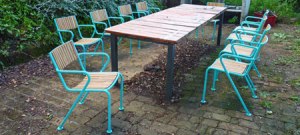Perhaps unsurprisingly in this year of odd, vaguely tropical, weather patterns a massive afternoon storm blew our annual Palio away on the scheduled date (19 August), turning the streets of the town into rivers and the stands of the football pitch where the final archery shoot-out takes place into gushing waterfalls.
(Don’t you hate that picture on the Palio website? Selfies are bad enough; but I would make photos of people taking selfies a crime.)
Down here in our valley, the storm was mesmerising and terrifying. I’ve seen more water fall in the same stretch of time (this was ‘just’ 44mm in an hour or so) but I can’t remember ever seeing so many lightning bolts fall right before my eyes, streaking down our field and out across the neighbour’s and down into the woods below. They crashed about and rattled the house which was, obviously, plunged into darkness after just seconds, along with the rest of town.
It was afternoon but the gloom was extreme. So L, in that romantic way he has, filled the place with candles – hastily extinguished in an ungainly scramble when C opened the cellar door and a stench of gas invaded the whole house. We opened windows and turned off gas taps by the cooker and out at the boiler. Then when the rain relented I identified a certain tell-tale pattern of bricks in the path around the house, dug down to expose the gas inspection pit, and turned the supply off there too… before realising that it would have been far easier simply to go up to our big LPG tank buried further up the garden and cut the stuff off at source.
The next day the plumber came and stared and shook his head and said “what on earth am I meant to do about this?!” then went away again – though not until he ascertained that we had the means to cook (a big gas cannister, which we attached to the stove) and take hot showers (our wonderful solar panels which mean that our boiler is switched off over the five/six months spring/summer anyway).
His explanation was that a lightning bolt, falling nearby, had sought out the copper gas pipe in some spot where there was a crack in the corrugated plastic tube it passes through, and had blown it open. But there was no telling where. Well, yes there was a way of telling where, of course, but it might involve things like take up our beautiful stone floor and generally creating havoc.
If I were better at playing the drama queen, the conundrum might have been solved there and then. Instead I lauded our self-sufficiency and sang the praises of solar panels, so it was a whole week later that they drilled through walls and paths and concrete to find the buckled bit of copper pipe that had failed to withstand the storm. Thankfully, the problem lay in the boiler room outside rather than beneath our floor. But there’s still a fair bit of patching up to do.
I could have demanded more immediate action but there’s a lot to be said, I think, for not putting too much pressure on your plumber, especially when he’s inundated by panicking punters. We’re blessed around here with tradesmen who, once they’ve worked on your house – and especially if they were involved in a big restoration – become more or less part of the family. Their prices are fair, you pay their bills (often weeks or even months afterwards because they’re mostly remarkably reticent about billing), and in return you get not only work well done but the right to summon – or at the very least message – them at any kind of inconvenient moment. Over the years, I’ve had plumbers and electricians here on Easter Sunday and Ferragosto (the sacrosanct August 15 holiday) and at all times of the night. But as I said, it’s a good rule not to cry wolf: they know that if I’m demanding instant intervention, it’s for a very good reason.
The Palio did eventually take place, one week later and in tingling autumnal-feeling sunshine – far more clement than what the forecasters had promised. And we won! Borgo Dentro sailed to victory. Not that we were there to witness it: we had a dinner engagement elsewhere. But we were there the following evening for the speeches and the photo-ops and the spumante-showers and the massive bull-shaped cake and the deafening shouts of Palio-winning euphoria.
For many years, we’ve been following the (non-)progress of what I’m now calling the Emperor’s New Housing Estate. At some point soon after a very pretty valley on the north side of town had been blighted by the construction of the ugly new Carabinieri barracks and a sweep of ring-road, ground breaking began on the other side of the road and a hoarding went up showing a cluster of little box-like houses which would soon appear.
They didn’t.
This may have been as long as ten years ago. Since when, at odd times, earth-moving equipment has materialised, areas have been leveled, pipes have been laid, horrendous stone walls have gone up. The billboard grew more dog-eared and many periods of many months went by when the only thing moving was the weeds that had engulfed the hillside.
The most recent developments are startling. First, in the spring, the landscapers moved in, swathing steep inclines in horticultural fleece, laying irrigation pipes and planting shrubs so far apart from each other that they have no hope whatsoever of ever covering the banks. Shiny new road surfaces were laid, complete with glow-in-the-dark white lines and orders to ‘stop’. Dozens of quite well advanced trees were planted though I fear, here, the irrigation was neglected because there has been a high mortality rate over the summer.
The cherries on the cake are the outcrop of primary-colour playground equipment erected in the forlorn little traffic island at the heart of the ‘estate’ and the lonesome park benches positioned with views over the beautiful old stone washing tubs… and the Carabinieri barracks.
All that’s missing, in fact, are the houses. Of which there is no sign.
Is this an oversight? Should someone tell them? Or perhaps it’s a weird performance – something to do with Il Giardino dei Lauri just down the road.
Whatever the explanation, it’s shockingly ugly.
One good thing – perhaps the only good thing – about getting your tomatoes planted shamefully late is that you find yourself with great piles of ripe fruit so late in the season that the time-consuming chore of making passata ends up being done on cool late-summer evenings rather than in the heat of high summer. (I’ve provided a link to one of my recipes though I see that’s it’s an old old one that I’ve long since abandoned. I now steam my tomatoes – stems and tough bits removed – until they’re soft, then push the whole lot through the mouli. No garlic, no cooking the tomatoes. This pulp goes straight into sterilised jars, each with one nice big basil leaf in it, and gets pasteurised as per the old recipe.)
I’m slightly dismayed that the various pumpkin-y looking seeds that I sowed then planted are everything but pumpkins. How on earth will I cope without my own? I have courgettes (unimpressive) and melons (refusing to ripen) and the usual crop of cucumbers galore, but not a single pumpkin. How did that happen? The mysteries of what goes into and comes out of my little greenhouse…















